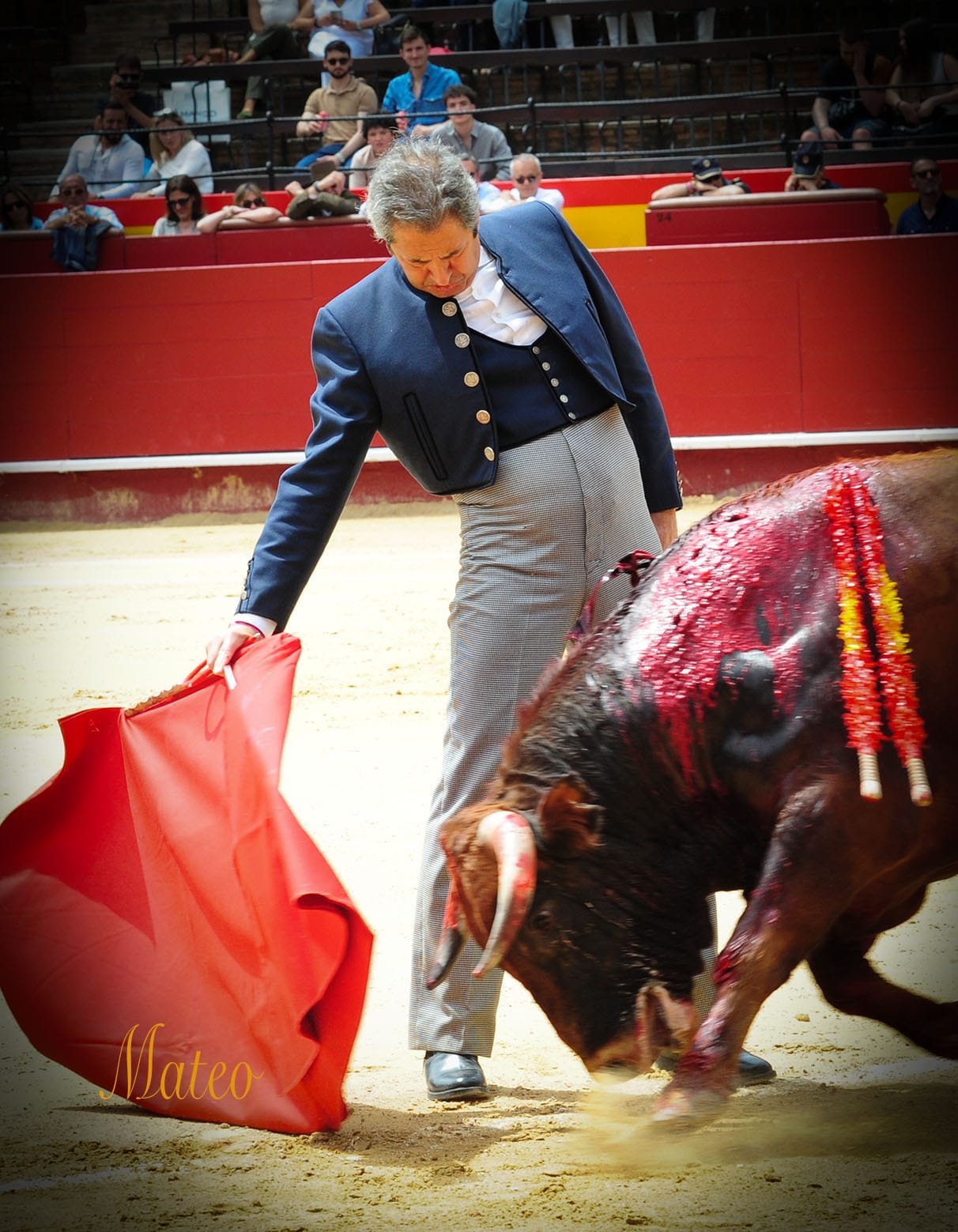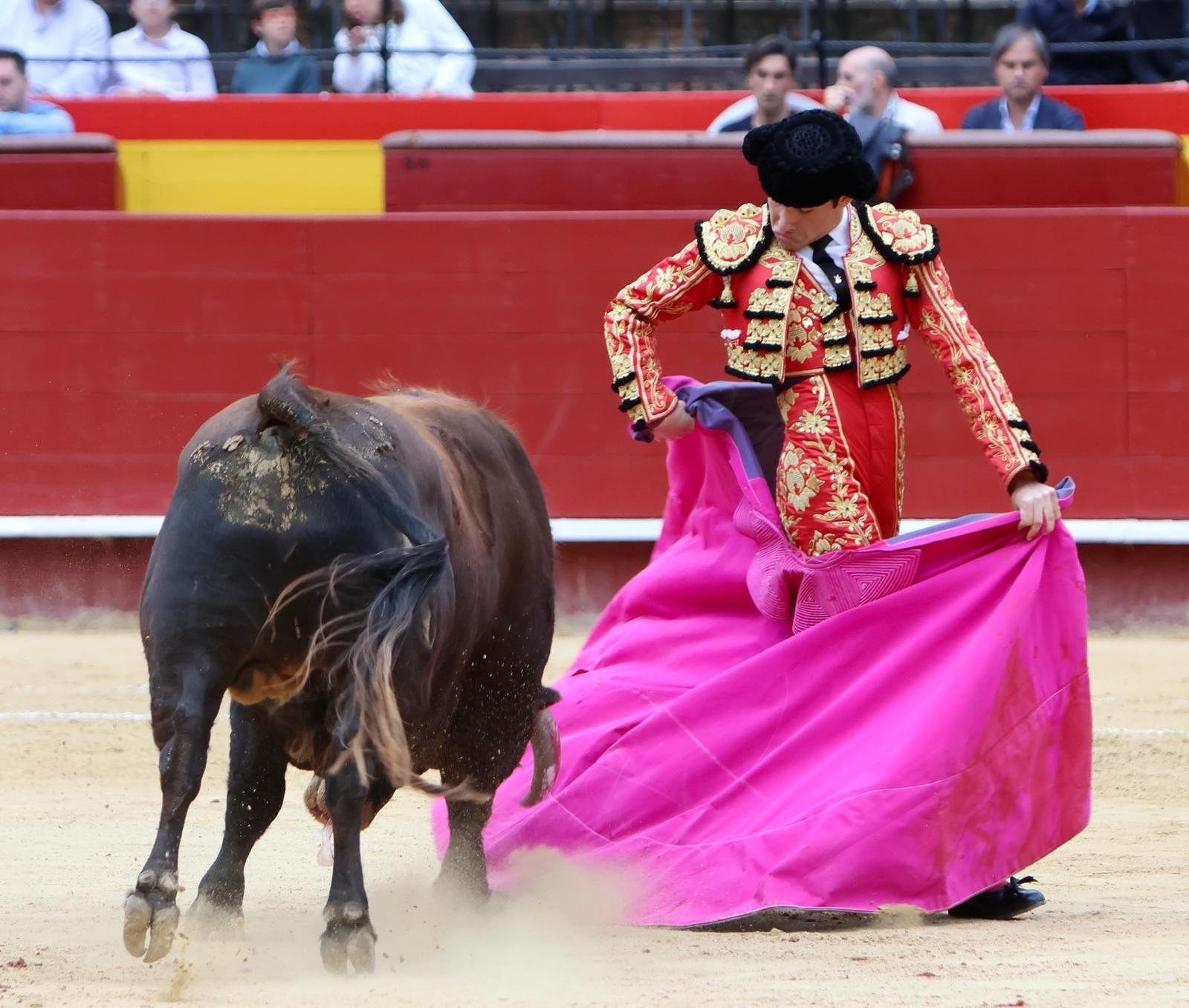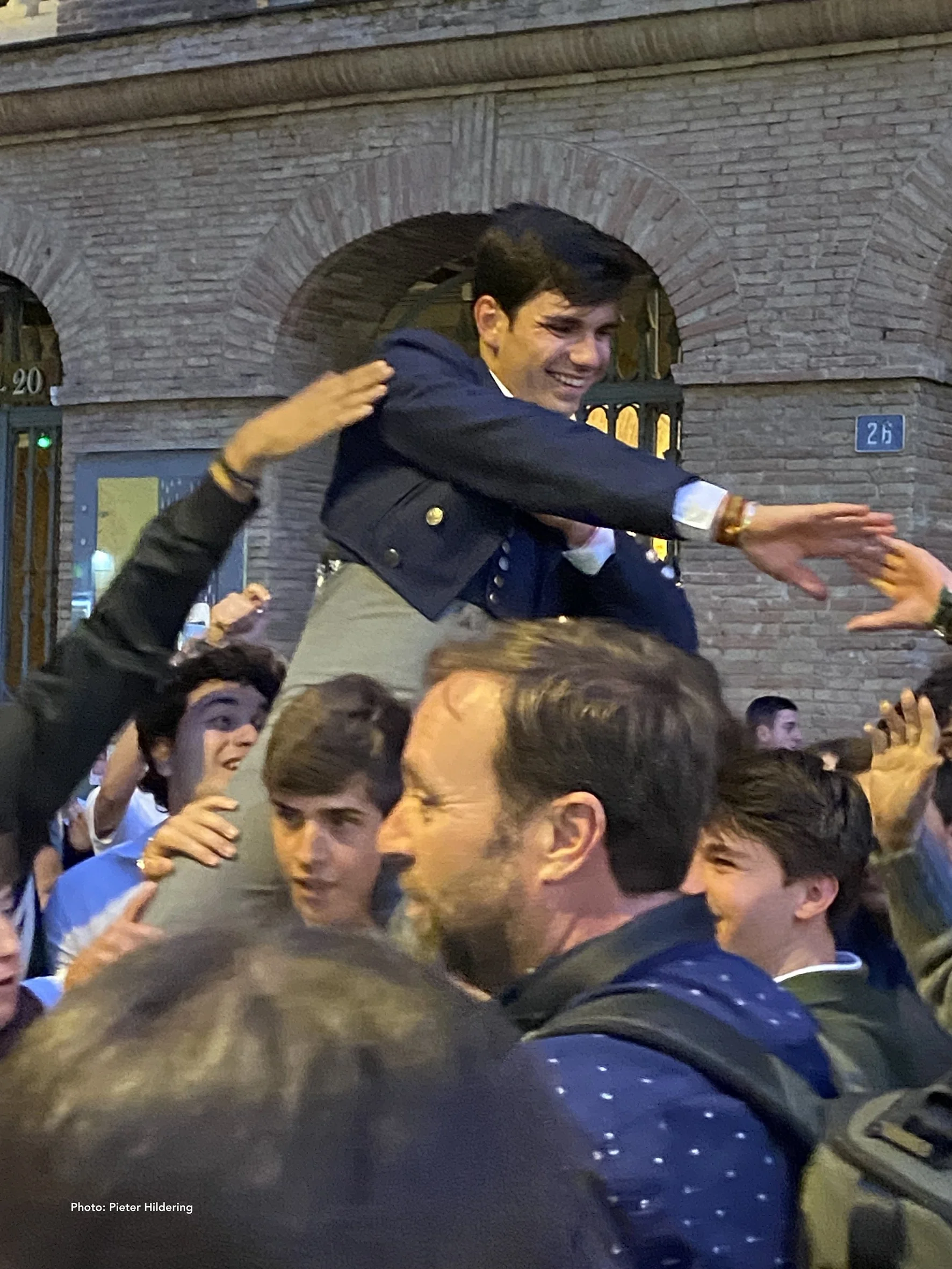Vicente Barrera & Alberto Donaire return to Valencia
Pieter Hildering
Vicente Barrera, May 11 2025 (image by Mateo)
Vicente Barrera Simó (1968) made his debut in 1992 aged 24 in the temporary arena of San Pablo de los Montes and came to Valencia one year later for a novillada with Jandilla bulls and Manolo Carrión and Rivera Ordóñez. Everyone wondered what the grandson of one of the town’s greats had possessed to choose a career in the bullring while he had finished law school and could well have found himself an easy job in the family business. And, although he left the ring emptyhanded, we were convinced that, although genes had skipped a generation, grandfather Vicente Barrera Cambrá (the two never met) had a worthy successor. We were proved right when the grandson later left the Maestranza on shoulders, the first Valencian novillero ever to do so and something his grandfather never did.
When Valencia’s afición discovered Vicente Barrera, Alberto Donaire was still a glint in his father’s eye. He was born in Calahora in the province of La Rioja in a family of modest toreros, his father and uncle banderilleros in the cuadrillas of local men. His parents moved to Valencia in 2018 so Alberto could enroll in the escuela taurina.
I first saw him in the impressive village arena of Utiel two months after he made his debut sin pics in the monumental bullring at Bocairent. He was 14 and the smallest novillero I had ever seen. To watch his colleagues perform, he had to step onto the sand as he was too small to look over the wooden fence. But, once his turn came, he grew in stature. It was great to see the magenta and blue cape of the 14-year-old slowly guiding his Palmosilla eral through every pass. Surely the spirits of the old masters had invaded the soul of this young bullfighter.
On his final corrida, 20 years after his debut, Vicente Barrera left on shoulders after cutting one ear from each of his Juan Pedro Domecq bulls. When the Valenciano retired from the world of bulls, Donaire was five years old. Barrera entered that of politics and in time became Minister for Sports and Vice-President of the Generalitat Valenciana for the ultra conservative Vox Party. The latter position he only held for a short period of time until head office withdrew the Party from the coalition governments it had formed in several Spanish regions.
Meanwhile, Alberto Donaire’s reputation was steadily growing, although this didn’t reflect in the amount of novilladas he was invited to participate in. I saw him again in May 2022, in a becerrada with five young colleagues and novillos from Aiden Jovani, a ganadero from Castellón which would become a steady supplier of young bulls for the many novilladas sin picadores – a result of taurine schools popping up everywhere – that were being held all over the country.
Our next meeting was in August of that year during the ‘International Competition for Escuelas Taurinas’ in Málaga’s La Malagueta. His fenomenal capework and incredibly slow flowing muleta – I was fortunate to watch him close by from a burladero in the callejón – were rewarded with a well-deserved ear and a place in the final. A day later and dressed in a white suit with silver trimmings, Alberto joined Ernesto Lorenzo and Manuel Fuentes Bocanegra to face becerros from Buenavista. Unfortunately, his luck ran out and he had to concede first place to Bocanegra. But I was glad to have seen this young torero withstand the en vogue kneeling passes, the sidestepping ‘bull behind my back’ moves, the rushed chicuelinas and its endless variations.
In September 2023, after 28 becerradas and winning several important trophies, Donaire made his debut with picadores during the taurine week of Algemesí in a mano a mano with Nek Romero and four novillos from Virgen María. He was unlucky with his allotted adversaries and, although he killed his last with a fine estocada, he left the arena empty handed.
The following year I saw him twice. In March, his sword failed him in a Chamaco novillada.
Then came 6 October. After Donaire gave a series of clock-stopping verónicas and equally slow pases with the muleta, the Rocío de la Cámara novillo started to hesitate, making it difficult for Alberto to continue his faena. He was caught on the horns in his attempt to kill the bull, and, after several stabs with the descabello, the trumpet sounded the dreaded third aviso. Alberto was forced to retreat from the battlefield, albeit accompanied by an encouraging ovation.
Diego Bastos and Alejandro Chicharro, the other two novilleros on the cartel, had already cut ears when Alberto's last bull entered the ring: a brown-spotted jabonero brute of a beast. Again, he welcomed it with his typical slow verónicas and led the bull to the horse with excellent walking chicuelinas. The faena was a collection of muletazos de frente on both horns, slowly circling the bull around while solid pases de pecho ended every series. We’ll never know whether things went too well for him, or it was bad luck. But, while attempting the estocada, the right horn caught him, threw him down and caught him again before throwing him back on the sand. It all happened in a fraction of a second. The young torero was picked up and rapidly carried to the infirmary. A medical statement later issued by the medical team read as follows: “Alberto Donaire was transferred to the University Hospital of Valencia after undergoing surgery in the bullring infirmary for a cornada measuring three to four centimeters rupturing the anal sphincter muscles.” In addition, the young bullfighter suffered “several blows to the chest, neck, and left shoulder,” according to Dr. Cristóbal Zaragoza, who went on to describe the injury as “very serious.” The audience rewarded the unfortunate novillero with the ear of the novillo which his cuadrilla delivered to the infirmary.
Two weeks later, continuing heavy rainfall caused incredible damage to neighbouring villages and took the life of 230 Valencians. Almost at once, the country joined forces in support of the victims: thousands of volunteers helped to clean up the streets while the taurine community organized Festivales Taurinos A Beneficio De Los Damnificados De La DANA everywhere. It was about time the provincial capital organized one too.
Alberto Donaire back in Valencia (image by Mateo)
On Saturday 10 May 2025, six colorado novillos from the ganadería 'Casa de los Toreros' (a ‘recent’ Domecq subsidiary) waited for Borja Escudero, Nacho Torrejón and the long-anticipated return of Alberto Donaire. This was the novillada I had come to Valencia for. Like everyone else in the plaza, I was anxious to see how and if the 20-year-old had recovered from his ordeal. But what was I hoping to see? His Paula-esque capote? His very personal approach to toreo, so different from his peers? The belmontinas during his faena? I would be content to see a bit of all of this, as long as he stayed in one piece. Everything else was a bonus. Word was, he reappeared against the advice of his doctors and was still undergoing treatment for the serious injuries he had sustained from the Rocío de la Cámara novillo six months earlier. Judging by the flowing capote and the typical chicuelinas with which he led his novillo to the horse, he seemed to be all right, quite confident even, smiling as he moved the bull. A lovely series of naturales, with a molinete thrown in for luck, seemed to assure his confidence until the bull hooked his leg and threw him aside like a rag doll – and once again as the novillero attempted the estocada.
His second animal was well piced and excellently prepared by his cuadrilla, headed by uncle Juan Carlos. He started his faena with some solid pases de castigo, leading his bull to the centre of the arena, forcing him into the muleta. But, after a series of well-placed naturales, the Casa de los Toreros novillo stopped halfway in every pass and Donaire had to use all his wits to stay clear of the horns. Yet again, his sword failed him and Alberto left the bullring emptyhanded but with a heavily bandaged left leg where his first opponent had punctured the skin. He wasn’t back to full form just yet, but I was glad to know he was on the road to recovery even though today hadn’t gone as he’d probably imagined.
The following day at noon, Valencia’s aficionados came to see their matadors Enrique Ponce, Vicente Barrera, José María Manzanares, Román and the novillero Simón Andreu confront five especially-prepared novillos from Álvaro Núñez. To top it all, four local recortadores would dodge, confuse and do summersaults over a five-year-old Alfonso Martín bull. At last, the capital celebrated its Festival In Support Of The Victims Of The DANA.
Enrique Ponce was awarded an ear for being Enrique Ponce and for his generosity in taking part.
It had been 14 years since 56-year-old Vicente Barrera last confronted a bull in the Valencian arena. His hair was turning grey and his physique had slightly filled out, but when he took the capote it was like he had never left. Perhaps his joints were in need of some lubrication, but his verónicas flowed as in his active years and, instead of the cold, distant Barrera they used to see, the veteran gave the astonished public an unexpected and heartwarming faena for which he was passionately applauded and given the ear of the animal. ‘A torero isn’t made: he is born’ was never more appropriate.
José María Manzanares was dealt a difficult, manso bull that went for everything in sight and seemed indomitable. As the novillo would not charge the horse, the torero sent the picador away and brought the bull under control with a few flicks of his capote. He then ordered the varilarguero back to his position. Manzanares showed us why he is the man who can read a toro’s mind from the moment the animal jumps into the ring until he puts the sword in. It got him an ear.
Román got one too, although for a slightly mechanical appearance and kneeling on the sand with his back to the bull. The novillero Simón Andreu, who won the competition in Málaga one year after Donaire reached the final, was less fortunate, but received a generous applause. The afternoon ended rather anticlimactically with the four recortadores and the Adolfo bull accompanied by throbbing disco music and a man with a microphone who told us rather loudly what was happening in the ring and why we had to applaud it.
But the story of this mini-May feria of the Virgen de los Desemparados and two of its main protagonists would not be complete without mentioning the six students of different taurine schools who showed us their progress in an ‘extraordinaria clase práctica’ with two-year-old bulls (rather large two-year-olds) from Aida Jovani. It resulted in Hugo Masiá, from Valencia’s escuela taurina, being the only torero to go through the Puerta Grande over the course of the three days.
Hugo Masiá carried out on shoulders (image by Pieter Hildering)


